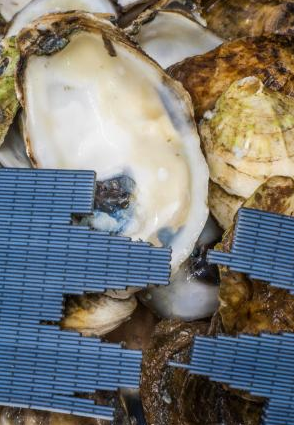3D printing technology is advancing rapidly; NASA is developing 3D printed pizza and MIT researchers are applying the principles of a bone’s structural arrangement onto the creation of 3D printed materials. The resulting compound is formed by printing two polymers simultaneously in a brick-and-mortar pattern and is significantly stronger than its individual components.
Natural durability
Organic bone is a durable substance that’s highly resistant to fracturing because it disperses energy from the point of contact, and redistributes damage over a larger surface area. This is accomplished by the two integral components making up bone, the soft collagen protein and rigid hydroxyapatite mineral, and the complex hierarchical patterns into which they are arranged.

Brick-and-mortar pattern of artificial bone and nacre. Image courtesy of phys.org.
While simple in theory, the primary challenge faced by researchers was designing a structure adapted for the additive nature 3D printing; but rather, re-creating the actual physical model. The structural arrangement naturally found in bone is difficult to reproduce in a laboratory setting because it forms through naturally occurring electrochemical reactions.
Two types of polymers imitate bone constituents
To overcome this issue, Markus Buehler of MIT’s Department of Civil and Environmental Engineering and his colleagues used soft and stiff polymers simultaneously printed from a 3D printer to imitate the combination of collagen and hydroxyapatite. The two materials are incapable of structural support on their own, but they form a potent amalgamation when combined.
According the Buehler, “the geometric patterns we used in the synthetic materials are based on those seen in natural materials like bone or nacre, but also include new designs that do not exist in nature. As engineers we are no longer limited to the natural patterns. We can design our own, which may perform even better than the ones that already exist.”
The synthetic result s
Buehler’s team created three synthetic compounds, all measuring about 5 by 7 inches and 1/8 inch thick, to put this knowledge into practice. The first composite is intended to simulate the mechanical properties of bone and nacre with its microscopic pattern resembling a brick-and-mortar wall. The mortar is embodied by a soft black polymer while a rigid blue polymer functions as the bricks. The second composite uses an inverted brick-and-mortar pattern to simulate the mineral calcite. Lastly, the third composite improves upon the bone’s actual ability to disperse damage over a wider area, thanks to a unique microscopic diamond pattern.
After extensively testing the samples, researchers confirmed that they performed exactly the same as their computer simulated counterparts, and that the bone-like material was in fact the most durable. Graduate student Leon Dimas, who co-authored the research paper with Buehler, stated that the manufactured sample exhibited up to 22 times more fractural resistance than its strongest constituent. Buehler points out that this process signifies a cost-effective
Story via phys.org
What’s your favorite 3D printing material? Visit TechXchange and discuss the pros and cons of each.
Advertisement
Learn more about Digi-Key





